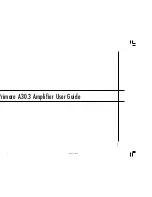
3
Figure 1. The 10x probe connected for monitoring the output signal
The load
The output impedance of the WMA-
005/005LF is 50kΩ. The amplifier is
generally
used
for
high-impedance
applications where the load is mainly
capacitive. This is the case for MEMS
devices,
EO-modulators
and
piezo
actuators alike. It should be noted that a
coaxial cable also presents a capacitive
load of approximately 100pF/m. The
cables
and
capacitance
that
are
connected often limit the maximum usable
frequency due to the first order RC filter
formed by the output resistance of the
amplifier and the connected capacitance.
If output monitoring is required, it is
recommended
to
connect
a
10x
oscilloscope probe to the output. A special
BNC to probe tip connector is usually
supplied with the probe (Fig. 1). However,
you can choose a different way of
connecting the oscilloscope, as long as
you mind the high output voltage. Pieces
of non-coaxial cable in the connection can
cause overshoot in the oscilloscope
reading.
The amplifier is capable of amplifying
above 9kHz, and should not be used for
telecommunication as described in the
R&TTE directive 95/5/EC. To prevent
unwanted radiation all cables should be
kept shorter than 30m.
Noise and offset
The WMA-005 is a low noise amplifier.
The output noise is typically below 3mV
rms. If this is not low enough, the
dedicated
version
WMA-005LF
is
available. It provides less than 0.1mVrms
noise: however, the bandwidth is limited to
DC – 50Hz (-3dB) instead of DC – 20kHz
(-3dB).
Power supply
Use a 24V DC power supply with a
continuous output current capability larger
than 200mA. If the power supply has an
adjustable current limit, it should be set at
200mA or higher too. Falco Systems offers
a suitable 24V power supply, for more
details please visit
www.falco-systems.com/products.html
Amplifier characteristics
In the following pages several amplifier
characteristics are shown:
- Frequency response (Fig. 2, 3)
- Square wave response (Fig. 4, 5, 6)
- Influence of a capacitive load on a
square wave output (Fig. 7)
- Triangle & sine response (Fig. 8, 9)
- Noise & offset (Fig. 10, 11)



























